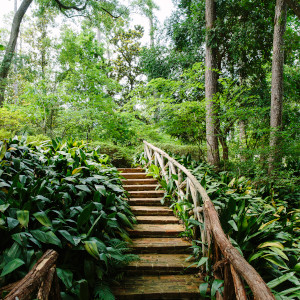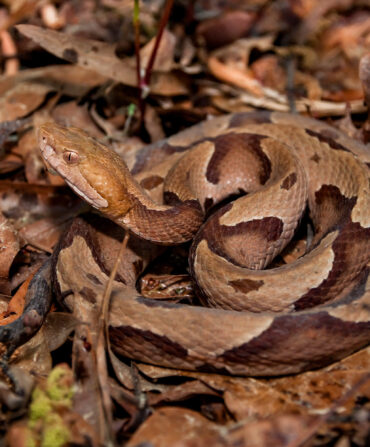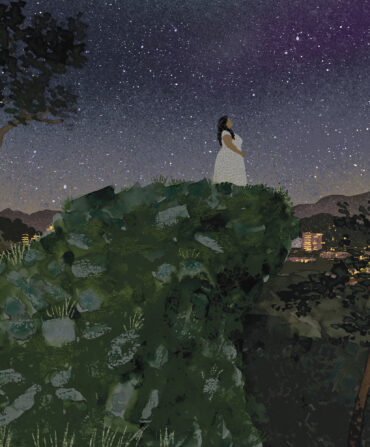The first gift I remember my paternal grandmother giving me was a touch-me-not. I was not quite six when Grandma Mary held out the plant, potted in a Dixie cup, to me and stroked its tiny fernlike leaves. I gasped as the fronds folded in on themselves at the stimulation. A little living curiosity, that touch-me-not became my first lesson in patience as I sat transfixed, waiting for the leaves to reopen so I could force them to close again.

This offshoot came from a larger bush near Grandma Mary’s front doorstep. As she sat on her porch watching cars travel the highway, she would sometimes mindlessly caress the leaves, feeling them furl and unfurl like a slow heartbeat. It wasn’t until I was an adult that I realized this perhaps was her version of meditation.
Grandma Mary’s yard in South Carolina looked to me like a botanical garden, filled with all sorts of species—water lilies in her front yard, string of pearls succulents around the toilet tank turned birdbath. Every time I pulled up to her house, I knew something would be in bloom. She accumulated plants however she could, trading cuttings with the other ladies at church, and occasionally, when we visited the sick and shut-in, asking the homeowner for a clipping of a specimen, and taking the not-much-more-than-a-leaf away in a wet paper towel or a water-filled mason jar.
I used to trail a car’s length behind her during those visits, embarrassed by her willingness to ask for a cutting instead of just purchasing a plant at Walmart. I never understood how a woman with a third-grade education and no access to high-level horticulture books puzzled out the plants’ care instructions or whether to cut above or below a node. I had not yet heard the word propagate. I just knew she seemed to always be moving about with some little scrap of something, nurturing it until it was fully grown and large enough to share. The pomegranate tree near the back porch—the first fruit plant I ever ate from—probably started the same way, as nothing much more than a stick, until it grew into the spindly bush that towered over my head, even in adulthood. Later, I would learn the term biophilia, an innate love for and connection with the natural world, and realized that was it. She had a special touch.
As an elementary schooler, I couldn’t coax forth the signature puffball pink flowers of the touch-me-not to blossom, but I did manage to keep it alive for a year, long enough that the family believed I had the gift too. And so the summer I turned eight, Grandma Mary gave me another mesmerizing surprise: a Venus flytrap. The inside of the “trap” lobes blushed rose pink, reminding me of a heart. The carnivorous, or insectivorous, plant grows only in the coastal plains of North and South Carolina, so the flytrap thrived in that humid August heat. And while it eventually succumbed to starvation, attempting to nurture the harder-to-care-for charge kicked off my fascination with carnivorous plants.
When I got a little older and could peruse the World Book Encyclopedia, I discovered species beyond my grandmother’s garden. I learned about and sought out other coastal Carolina carnivorous varieties—sundews, bladderworts, butterworts, pitcher plants—which stoked my desire to travel the country to see more rare plants. I started not too far from home, with the Atlanta Botanical Garden (ABG) and its heralded, extensive pitcher plant collection.
Abutting Piedmont Park in Midtown, the thirty-plus acres of indoor and outdoor gardens immediately struck me as a world-class expansion on what Grandma Mary was trying to achieve in her yard: an ever-blooming sensory fantasy, always something to smell and see, hip-high pots overflowing with pansies in lieu of toilet tank–bound tropical plants.
In the years since that first visit, the ABG has become a four-season destination for me. Even as I travel the wild, swampy, no-phone-service corners of the South as a writer, this man-made oasis in the middle of a city offers my heart incomparable solace. Anytime I can squeeze a couple of free hours into my itinerary, I make a pit stop in Atlanta to spend an afternoon wandering through the verdant serenity and dreamscapes of green. I even have an annual membership—my only one—although I live three hours away.
When I arrived there this past spring, the daffodils and hyacinths had already died down, and along the walkways the last of the tulips listed sideways. Next would come the azaleas and roses, which blossom right before the hibiscuses. Then the seasons would shift with the unfurling of the voodoo lily, also known as the corpse flower, its name nodding to its incredible stench.
Fuqua Orchid Center, located at the back of the ABG, is a study in contrasts, ancient plants encased in glass and steel to ensure their survival. The orchid family developed roughly 85 million years ago, during the time of the dinosaurs, and they might just be the oldest flowering plants in the world. The massive conservatory functions as part rainforest, part sauna, and when I opened the door, the scent of earth and dampness greeted me.
Inside sat marvels from faraway places I hope to visit one day. I learned about the important roles different species of hummingbirds, the ones responsible for pollinating my favorite orchids, play in the Andes Mountains. I paused in awe of Mount Kinabalu on the island of Borneo, in Malaysia, home to the world’s most extensive, diverse assortment of orchids and more than fifty species of pitcher plants. I read about tepuis, remnants of sandstone plateaus that soar above their South American surroundings, functioning like islands in the sky. Placards in front of new-to-me species explained how, with these mesas isolated from the forest below, evolution created plant and animal species that live only there—and at the ABG.
Beside the orchid center, in the Skyline Garden, a little man-made bog hosts pitcher plants from wetlands around the South. This easy-to-overlook area is my favorite spot in the garden, at turns serene and vibrant, a panorama of Atlanta’s skyscrapers peeking above the tree line. The bog may be no match for the kaleidoscopic orchids next door, but the delicate carnivorous plants there always make me think of my childhood botanical crush on them, and of Grandma Mary.
It wasn’t until she died, and I walked her land one last time, that I realized some of the flowers in her yard were artificial. Without her meticulous care, the silk and polyester petals had faded under the Southern sun, and the green fabric leaves had frayed. Of course, I realized, belatedly, the world cannot be in bloom all the time. But even a likeness can captivate. The ABG deploys this trick, too, so that there’s always something to discover on the property, be it a nature-themed art exhibition or an installation of a corpse flower made from blown glass. By the end of that trip to the ABG, I had added Canaima National Park to the list of places I want to travel. The UNESCO World Heritage Site contains Auyán-tepuí, a Venezuelan mountain that’s home to Angel Falls, the world’s tallest uninterrupted waterfall. The tepui’s heart-shaped plateau features especially steep walls and a completely flat peak. All the unique species up there at the tip-top, all the wildlife I haven’t seen—the ABG has enchanted me again.
That is why I love this place. Though so close to home, it has the potential to take me around the globe. All it takes is a spark—a little scrap of something, a leaf maybe, a bit of branch nurtured till it can take root. The world is bigger. The world is smaller.
Grandma Mary knew it. It just took me a little longer to understand.








